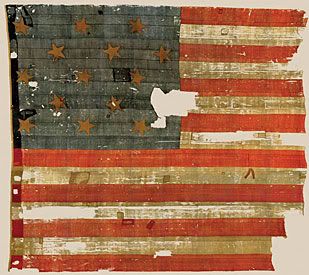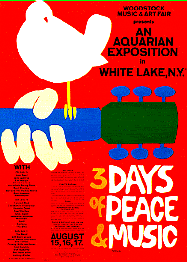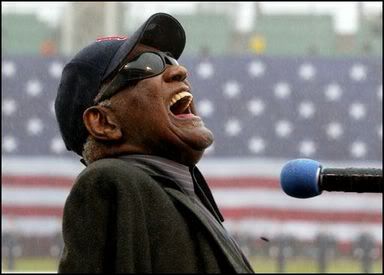I grew up in Pasadena, California, home of the Tournament of Roses Parade and Rose Bowl Game, the Huntington Library, Art Collection and Botanical Garden, the Jet Propulsion Laboratory --- and one kicking Fourth of July fireworks show.
Pasadena’s celebration of Independence Day is Southern California's biggest. It is held in a stadium big enough to hold a hundred thousand people, with thousands watching from their picnic locations in neighboring Brookside Park and many more enjoying the display from their homes all around the Arroyo. It’s a great show, always featuring a band and singers performing patriotic tunes, but growing up, we thought it was much more enjoyable to look out at the fireworks than straight up at them.
After a time or two, we rarely went to the Rose Bowl to see the show.
Instead, my parents would prepare a big barbecue at home and, after the meal, we would light sparklers and watch the white hot embers fade as they fell onto the brick patio. Then the five of us kids would go up to the second floor and wait for the sky to light up in the distance. We knew where to look, but the hero of the night would be the first one to point and shout, “Hey! It’s starting! Look over there!”
I’ll never forget those hot July nights, stuffed to the eyeballs with hot dogs and potato salad, the smell of sweet ripe watermelon still on our fingers and then, at last, a spectacular light show, just before the dreaded call “Children, bedtime!”
Waiting in the gathering darkness, we’d provide music of our own, singing a few of the patriotic songs we’d learned in school: “Yankee Doodle”, “You’re A Grand Old Flag” and my favorite, “America the Beautiful”. None of us ever tried to sing the national anthem, “The Star Spangled Banner” --- with its sweeping range and difficult transitions, it didn’t sit comfortably on our tongues.
As I grew older, I wondered why our national song was a war hymn that ended with a question.

Star Spangled Banner
Oh, say, can you see, by the dawn's early light,
What so proudly we hail'd at the twilight's last gleaming?
Whose broad stripes and bright stars, thro' the perilous fight,
O'er the ramparts we watch'd, were so gallantly streaming?
And the rockets' red glare, the bombs bursting in air,
Gave proof thro' the night that our flag was still there.
O say, does that star-spangled banner yet wave
O'er the land of the free and the home of the brave?
- Words from the poem "In Defense of Fort McHenry", written by Francis Scott Key, September 20, 1814. Sung to the tune of the drinking song “To Anacreon in Heaven,” attributed to the British composer John Stafford Smith.
“The Star Spangled Banner” has been popular since its composition during the War of 1812, when Francis Scott Key wrote a poem commemorating the moment he saw the American flag still flying over Fort McHenry the morning after a battle with the British forces.
According to The Star Spangled Banner and The War of 1812 from the Smithsonian Institution’s National Museum of American History, the words and music were first performed together at the Holliday Street Theatre in Baltimore on October 19, 1814. During the century, the SSB became one of the country’s most beloved patriotic songs.
The song endured throughout the Civil War as a way for Americans to express love of country and, along with ‘Yankee Doodle’ and ‘Hail Columbia’, it was played on most patriotic occasions. By the end of the century, the military was using the song for official ceremonies and playing it at the raising and lowering of the colors.
The National Museum of American History continues, “Meanwhile, patriotic organizations had launched a campaign to have Congress recognize ‘The Star-Spangled Banner’ as the U.S. national anthem. After several decades of attempts, a bill making ‘The Star-Spangled Banner’ our official national anthem was finally passed by Congress and signed into law by President Herbert Hoover on March 3, 1931.”
It’s sometimes hard for me to hear the SSB without saying “Play ball!” in my head as the notes fade away, and I have discovered that there is a reason for that.
During the World Series of Baseball in 1918, the song was performed in honor of the troops fighting in the Great War. This was the first time it was played at a sporting event. It was a spontaneous moment and it was reported to have been deeply moving. It became a staple of every ball game, at first played during the seventh inning stretch, but formally adopted during World War II as the opening of every major league baseball game. I have some great memories of going to games at Dodger Stadium as a kid, singing rousing, off-key renditions of “Take Me Out to the Ball Game” and that other fun baseball song, the good old SSB.
In a few years my knowledge of the world would grow beyond the boundaries of those halcyon summer days. We had landed on the moon, a bitterly divisive war was ending, a president had left office under a cloud, women and minorities were striving for equal rights, and the child who had danced in front of the mirror, trying to become a female Fred Astaire (I’d seen him on “The Early Show” afternoon television movie), was listening to a different tune.
My brother James, who is now the professional musician he dreamed of being in those days, thrust a mini reel-to-reel tape player in my face. (It was the iPod of its day.)
“Listen to this.”
And blaring out of that portable player, in all its tinny glory, came the sounds of the revolution.
It was “The Star Spangled Banner” as performed by James Marshall Hendrix, once a paratrooper and member of the 101st Airborne out of Fort Campbell, Kentucky --- and now, as Jimi Hendrix, the most innovative and acclaimed rock guitarist of his time.
Jimi Hendrix - Star Spangled Banner, Woodstock, NY August 18, 1969
As Wayne Pernu writes in Star Spangled Banned:Anthem of A Generation “Jimi Hendrix's performance of ‘Star Spangled Banner’ at Woodstock was a turning point in the history of the counter-culture movement.
The sounds Hendrix drew from his Fender Strat were literally an aural recreation of war. In between the machine-gun fire, bombs dropping, smoke billowing from napalm blazes, and a wrenching undercurrent that evoked the agonizing polarity which tore our country apart and destroyed Vietnam, Hendrix treated the song with surprising reverence... While people presume "Star Spangled Banner" to be defiantly anti-war, it is no such thing; such a notion limits the scope of the piece... Eric Burdon [lead singer of The Animals] recalled that when Hendrix arrived in England he spoke fervently about the need for the United States to subdue Chinese Communism before it overtook the world. It is important to remember that Hendrix had been on both sides of the fence, experiencing attitudes toward the war as diametrically opposed to one another as could be... At the same time, Hendrix possessed a pacifistic nature that certainly contributed to the work's radiant objectivity.”
Jimi was my brother’s musical hero, and he devoured everything he could find on Hendrix. I don’t recall where James got that bootleg --- perhaps handed down through his musician friends, perhaps taped from the audience in the theater where the “Woodstock” documentary film played the following year. I do remember that my childish ears had never heard anything like it.
Many prefer traditional interpretations of The Star Spangled Banner and some even consider radical reinterpretations of the anthem to be disrespectful. I am a patriot of the left wing and I know that protest for many (no, not all) was born out of love for this country and a fervent desire to see it become the best it could be. Though it is not for all tastes, Hendrix’s version was a way of combining his formidable musical genius with a new interpretation of a patriotic tune, relevant to his life and his experience.
Who were the people who experienced Hendrix? They were the thoughtful, the self-indulgent, the fun-loving, the disorderly, the revolutionaries, the camp followers, the libertines and the lovers of liberty --- all coming together at Woodstock, a musical celebration as out-of-this world as the moon landing a month earlier.

To place Hendrix’s performance in the context of its time, check out the 1970 Academy Award winning documentary “Woodstock.” Film critic Roger Ebert says of Woodstock “The Hendrix guitar solo is the most famous single element in the film, which uses it as a form of closure. As Hendrix begins, we see the concert grounds after most of the 400,00 have left, leaving behind acres of debris, muddy blankets, lost shoes. Then the chronology reverses itself to show the field filling, until finally we see the whole expanse of the mighty crowd, as Hendrix's guitar evokes rockets bursting in air.
‘Woodstock’ is a beautiful, moving, ultimately great film. It seemed to signal the beginning of something. Maybe it signaled the end. Somebody told me the other day that the 1960s has ‘failed.’ Failed at what? They certainly didn't fail at being the 1960s. Now that the period is described as a far-ago time... how touching it is in this film to see the full flower of its moment, of its youth and hope.”
What has happened to the echoes of Woodstock Nation? My brother James has lived in Italy for many years, touring the world with some of the most famous musicians of the past twenty-five years. His teenage son was born and raised in Italy, and his favorite musician is --- Jimi Hendrix.
Though I was a tad too young to appreciate the times --- except with my copycat little sister “hippie” clothing and hair --- I now appreciate so much about that era, particularly its music.
The musicians of that time sang a different song of America, but it was a song of our nation all the same.
(For more about Woodstock - read our blog Revisiting Woodstock: Or Playing In The Mud or Clay

For the last three years, when I think of the Independence Day, I think of Clay Aiken. Clay has been a part of my musical landscape for just a few years now, but he is already one of my favorite Fourth of July memories.
Clay has an interesting and complex recent history with the holiday.
In 2002, he was a college student, sitting in the hospital where his stepfather, with whom he had a difficult relationship, lay dying.
In 2003, just beginning his transition from amateur to professional singer, he left rehearsals for the American Idol Tour to mark that anniversary with his family.
In 2004, as a chart-topping, best-selling singer, he was selected to sing the Star Spangled Banner to open the PBS broadcast of “A Capitol Fourth”, which took place on the West Lawn of the United States Capitol in Washington DC. Clay also sang “Measure of a Man” and “God Bless the USA”, dedicating his performance to the men and women who were serving the country. Clay’s brother Brett had just joined the Marines.
During his time in the public eye, Clay has performed the SSB for the minor league Durham Bulls --- and at Game One of the 100th anniversary of the World Series of Baseball. He has sung the national anthem on D-Day, the sixth of June, at a NASCAR race in Dover, Delaware; at a basketball game for his alma mater, the University of North Carolina Charlotte; and at a Carolina Hurricanes hockey game. He sings it well, with an ease that conceals the song’s difficulty.
Clay’s performance for “A Capitol Fourth” is one of my favorites --- and it is worlds away from my memories of squeaky-voiced renditions in school auditoriums and boisterous shout-outs in summer ballparks.
Clay Aiken - Star Spangled Banner, A Capitol Fourth, July 4, 2004
In this rendition, Clay’s voice, though not perfect, is just beautiful, and I love the simplicity, the honesty and the respect with which he approaches the anthem. Some renditions are overly earnest and therefore feel insincere, a few have an unfortunate air of jingoism, others feel a bit like a star turn by the celebrated singers who perform it. Accompanied by the National Symphony Orchestra, Clay’s version is traditional but not staid, and it feels appropriate to the setting. There are other songs of the American experience that I would love to hear Clay sing, but I’m glad I have this performance in my collection.
“The Star Spangled Banner” has now been our national anthem for seventy-five of our 230 years as a nation. The more I learned about it, the more I respected the song and its history, but it is another song, with its imagery of a peaceful America, that touches my soul.
The song is “America The Beautiful”, and the soulful, heartfelt version performed by the legendary Ray Charles has become a holiday favorite.

Hear a sample from Ray Charles Sings For America
America the Beautiful
O beautiful for spacious skies,
For amber waves of grain,
For purple mountain majesties
Above the fruited plain!
America! America!
God shed his grace on thee
And crown thy good with brotherhood
From sea to shining sea!
From an 1893 poem by Katharine Lee Bates, melody from the 1882 hymn “O Mother Dear, Jerusalem” by Samuel Augustus Ward.
Like the SSB, “America the Beautiful” has many verses that are rarely sung, including some archaic language that would have contemporary Americans scratching their heads. But I love the song’s majestic imagery, its idyllic vision of a brotherhood shared by all Americans --- and the fact that you don’t have to be Ray Charles or Clay Aiken to sing it. It is not our national song, but it remains to me an anthem of reverent prayer and quiet celebration, just as it was to the little girl growing up in Pasadena, watching the fireworks and singing.
Now we celebrate the 230th anniversary of the birth of this country, a place that is centuries old but still experiencing growing pains. There has been discord and there has been magnificent courage. There have been war heroes, and peace heroes as well. There has been a myriad of opinions, from the left, the right and the center. And there has been the music, chronicling the changing times.
Administrations come and go, but the people and their music endure. This is my country. This land is your land, this land is my land. Born in the USA.
I’ll celebrate a while, but there is work left to do to achieve the dream.
Happy Birthday, America. On this Fourth of July, regardless of politics, of thee I sing.
(c) 2006 by berkeley
Technorati tags: Clay Aiken
Pasadena
fireworks
Independence Day
Fourth Of July
Star Spangled Banner
Francis Scott Key
War Of 1812
baseball
Ray Charles
Jimi Hendricks
Woodstock
Roger Ebert
A Capitol Fourth
Measure Of A Man
God Bless The USA
America the Beautiful
Katharine Lee Bates

3 comments:
Reading this made me so proud to be associated with this blog. This entry was just wonderful, and I learned several things I never knew. Thank you so much, and happy Fourth!
berk - Your post is beautiful and powerful, and moved m to tears...
Like you, I was a little too young to truly appreciate what Hendrix had done with his icnoic version of the SSB back in 1969.
I haven't really thought much about it since then.
But with this:
"The sounds Hendrix drew from his Fender Strat were literally an aural recreation of war. In between the machine-gun fire, bombs dropping, smoke billowing from napalm blazes, and a wrenching undercurrent that evoked the agonizing polarity which tore our country apart and destroyed Vietnam, Hendrix treated the song with surprising reverence... "
...I finally get it. Thank you.
Wow, I'd never before realized that the song ended with a question.
I guess what it means is that we should never take it for granted. Or is that obvious?.. But it gave me back of the neck prickly's.
Thanks Berkeley!
Post a Comment